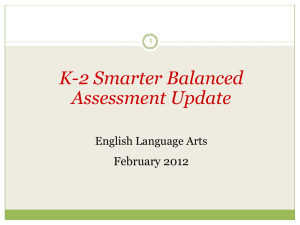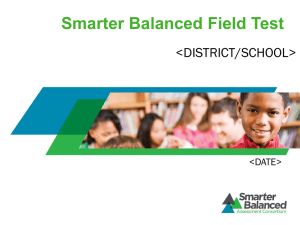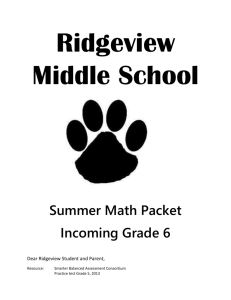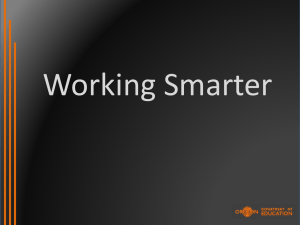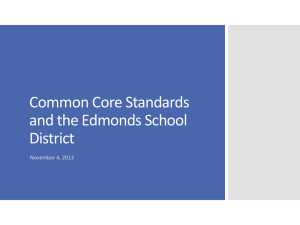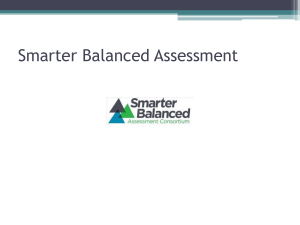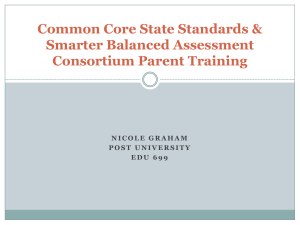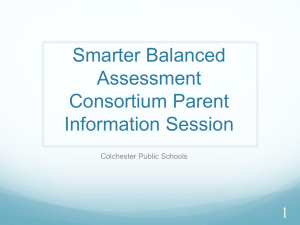6-8 Smarter Balanced Assessment Update
advertisement
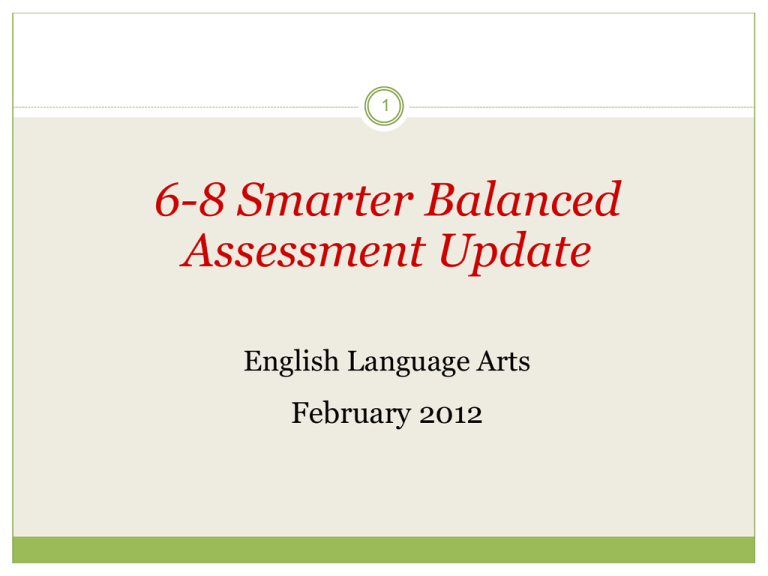
1 6-8 Smarter Balanced Assessment Update English Language Arts February 2012 2 Smarter Balanced Assessment Consortium Updates 3 Content Specifications for Summative Assessment of CCSS for ELA & Literacy in History/Social Studies, Science, and Technical Subjects Assess reading for both literary and informational texts (For percentages of text see p. 5 NAEP charts in the Common Core State Standards document.) Attention to reading closely Attention to reading texts of increasing complexity at all grade levels Smarter Balanced Assessment Consortium Updates 4 Assess 3 types of writing considering balance of types across grade levels (For percentages of text see p. 5 NAEP charts in the Common Core State Standards document.) Narrative Argumentative (Opinion/Persuasion) Informative/Explanatory Smarter Balanced Assessment Consortium Updates 5 Research and full compositions take longer to complete. These will be addressed through performance tasks rather than summative tasks. Smarter Balanced Assessment Consortium Updates 6 Language Standards: Not a test of vocabulary memorization Word analysis skills Close reading Determining meanings in context Interpret figurative uses of language A lexile or frequency count is only one consideration when it comes to determining text complexity. 7 Factors that influence text complexity (Hess & Biggam, 2004) Word difficulty and language structure Text structure Discourse style Genre and characteristic features of the text Background knowledge and/or degree of familiarity with content Level of reasoning required Format and layout of text Length of text Smarter Balanced Assessment Consortium Updates 8 There are 5 learning outcomes or CLAIMS for the CCSS ELA standards: 1. 2. 3. 4. 5. Read closely and critically to comprehend a range of increasingly complex literary and informational texts. Produce effective writing for a range of purposes and audiences Employ effective speaking and listening skills for a range of purposes and audiences. Engage appropriately in collaborative and independent inquiry to investigate/research topics, pose questions, and gather and present information. Skillfully use and interpret written language across a range of literacy tasks. Smarter Balanced Assessment Consortium Updates 9 What to expect with short research performance tasks for Claim 4: At grades 3-5, students might read/view and discuss a short informational article about a science topic, such as static electricity. Then they conduct a designed experiment with a partner to collect data about how static electricity behaves under certain conditions. Individually, students prepare and present their results to show that they can draw conclusions that integrate or compare what they read about and what they observed (using data collected and text evidence as support). Smarter Balanced Assessment Consortium Updates 10 Claim 4: Grades 3-5 students might be asked to read and discuss several short personal accounts of US citizens who immigrated to this country when they were children (firsthand accounts) And an article (secondhand account) about different immigration patterns across US history Then respond to a research question where they would have to integrate or compare both sources. Smarter Balanced Assessment Consortium Updates 11 Claim 4 Middle School Example 1. Collaboratively generate & explore a variety of potential digital and print resources that can be used to respond to a research question or problem. 2. Collaborative discussions would include considering the credibility of sources and relevance of information to the topic. 3. Individually, students prepare and present their results to show that they can draw conclusions that integrate or analyze information using data &/or text evidence as support. Smarter Balanced Assessment Consortium Updates 12 Claim 4 High School Example 1.Collaboratively discuss texts, speeches or media messages all of which present different points of view about an issue from a period in history. 2.Individually, students may be asked to select appropriate sources, then analyze and present information (academic writing/explanation) or critique perspectives/potential biases as they relate to the issue and craft a response (critique/argument). 3.Responses demonstrate the ability to analyze & synthesize information & evaluate sources (primary, secondary, media…) for credibility, bias, quality of evidence, and/or quality of reasoning. Smarter Balanced Assessment Consortium Updates 13 All short research projects will be assessed with extended responses/performance assessments, preferably over two or more days at high school. Whole group or small group collaboration may be used in the planning phase and (at least initially) be used as formative assesssment evidence. The summative assessment would be a presentation of learning—with some flexibility of medium used: oral, visual/graphic, written or a combination. All extended performance tasks will be scored analytically with trained raters and may also include a holistic scoring component. Smarter Balanced Assessment Consortium Updates 14 Optional Interim Assessments and Performance Tasks will remain optional and not a part of the reporting to the state. Will be available to districts at no charge in 2016 Smarter Balanced Assessment Consortium Updates 15 Districts will be given a 6-8-week window to test students during the last 12 weeks of the year. Unlike MME students are not tested at the same time, same place. Allows for flexibility, use of computer labs. Smarter Balanced Assessment Consortium Updates 16 Includes grades 3-8 and 11 only. Districts will use the digital clearinghouse provided by the state to create assessments for 9th-and 10th-grade students. However, those tests must be in place to comply with accountability laws in Michigan. State hopeful that once consensus is reached on purpose of the SMARTER Balance Interim Tests that the districts may use them. Smarter Balanced Assessment Consortium Updates 17 There is the possibility for students to retake the test up to three times. Districts determine who is retested. Reasons include sickness, extraneous issues that would be identified by the district. Smarter Balanced Assessment Consortium Updates 18 MEAP Science and Social Studies tests will be moved to the spring until new standards are approved and assessments developed. NRC-developed science standards about 1.5 years from adoption CCSSO-developed social studies standards about 2 years from adoption New tests for these areas developed after that time Smarter Balanced Assessment Consortium Updates 19 Accommodations for the summative assessments may be different from current practice in Michigan, as all states giving the SMARTER Balance tests must be consistent in providing accommodations. This will be determined after the tests have been developed. Smarter Balanced Assessment Consortium Updates 20 While Michigan is an integral part of developing the assessments, the state has not formally approved the tests. It waits for the final development and piloting to see if the system meets our needs. Smarter Balanced Assessment Consortium Updates 21 Funding only given for the development of the tests, not for the upkeep and administration of the assessments needed by the 2014-15 school year and beyond. Sustainability task force has been established and met for first time in December.
